Results 1 to 10 of 31
-
01-26-2014, 03:08 PM #1
 Ordovician Thuringian Hones II – The Escher Quarry
Ordovician Thuringian Hones II – The Escher Quarry
In another thread some month ago I reported on a special class of thuringian stones, which are harder than the well known soft thuringian hones like the Escher labeled waterwhetstones. These harder kind of thuringians are much older and were found in the Ordovician age stone formations in the thuringian area – in contrast to the soft waterstones that are found in upper Devonian layers. There were used with oil in the past.
The Ordovician age stones have been traded from the early middle ages on. The stones have been found in ancient European trading centers like Haithabu, which was a main centre of the Vikings around the 10th century. Also stones of this kind are found in at least one celtic oppidum in the thuringian area that existed 500 to 100 BC.
There are several quarries in the Thuringian and Frankonia/Bavaria area. Since all the stones from different quarries are somehow different in hardness, fineness and therefore also the usage in older times, it is interesting to discover the mines in detail.
In the last thread dealing with that kind of stones I talked about the so-called Hiftenberg quarry, which was the oldest known quarry in the thuringian area.
In this thread I want to give some informations about a quarry that was rented by the Escher family for more than 150 years. J.G Escher itself should have been said that this quarry has been has been in the hands of his family for more than 300 years but that’s not profen.
The history of the quarry began somehow in the 17th century or even earlier. In the archives you found that members of the Escher family rented the quarry from 1764 on, Johann Gottfried Escher signed a contract for rental 1804. From that time on the quarry was always in (rented) property of members of the Escher company, from 1870 on Bösenberg and Trinks & Co appear as renters. In 1925 the quarry was closed after an accident where 2 miners had been killed. Otto Brächer and again JGES rented the quarry later in 1937 and 1939 but without opening the mine again.
The stones from this quarry where noted as the best stones for jewellers, goldsmith, barbers and engravers in the 19th century. Berthold Sigismund, a well known regional historican of the thuringian area wrote in his Geography of the Schwarza territory in the year 1858 about this whetstones: “…..the stone is of the finest grain and is able to attack even the hardest engraving needles… ” .
It is reported that Caspar Escher, who represented the next generation after Johan Gottfried Escher and owned the Escher company in the first part of the 19th century, personally mined the stones with his daughters in a few summer months (he mainly got a toy-store at this time in Sonneberg, Thuringia).
Because of their red spots that according to the literature, only the best stones have, they were called Troutstones by the miners. There are also white, gray, yellow and green stones without spots that are quite of good quality. However the stones were sold by the Escher company under the name Sächsischer Oelstein (translated Saxonian oilstone).
The name is a little bit misunderstanding nowadays, because the quarry where the stones came from is located in the federal state of Thuringia and not in Saxonia, Germany. However there was a time in the past centuries (17th-19th), were Sonneberg, the location of the headoffice of the Escher company belonged to the dukedom Sachsen-Meiningen and I suppose that the naming of the stones was based on this historical background.
The stones are very hard oilstones somehow comparable to translucent Arkansas stones.
Since the material is very hard and stable you can cut nearly all possible forms of it like slip stones, files and form stones. The stones therefore have been in competition to imported Arkansas stones in the 19th century.
The following picture show some different shaped stones from the estate of the IGES company:
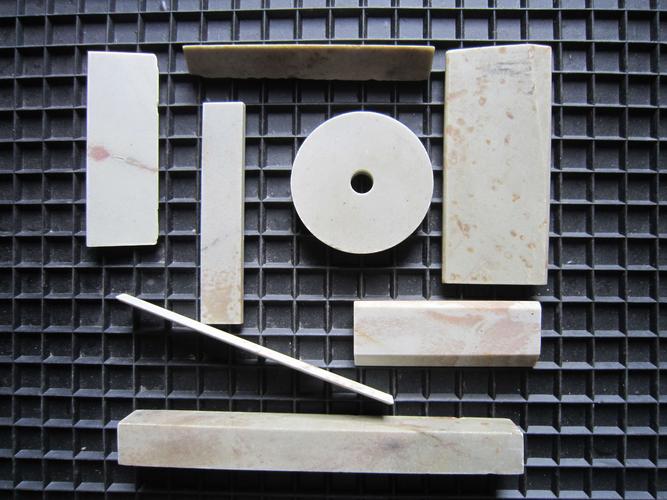
In fact, the stones could be easily mistake from the visual as well as from the performance with Arkansas stones. So be careful if you found an old ancient Ark, it could also be a Saxonian oilstone.
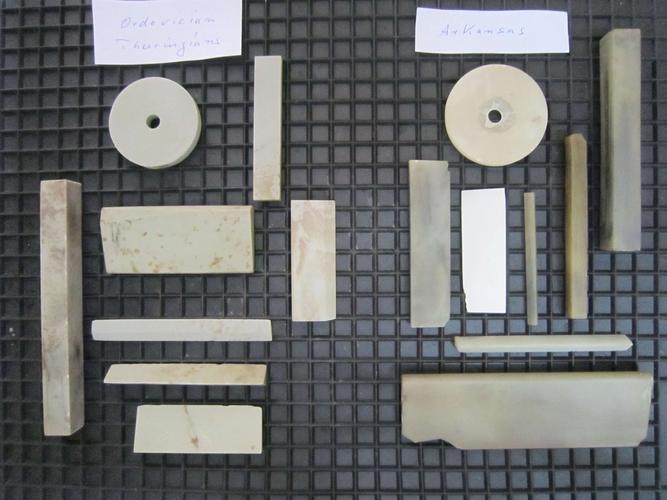
Having read about the stones a lot in ancient literature and I also found copies of some old company letters of the Escher company where the stones are mentioned, I always hoped to find a labeled stone while searching and asking mainly in the Thuringian area the last couple of years - but never did find any.
Finally some month ago, I found such a stone – in the States! The seller got him from an old man together with other antique things. Maybe he or his ancestors were immigrants from Germany, however the label is in german language only.
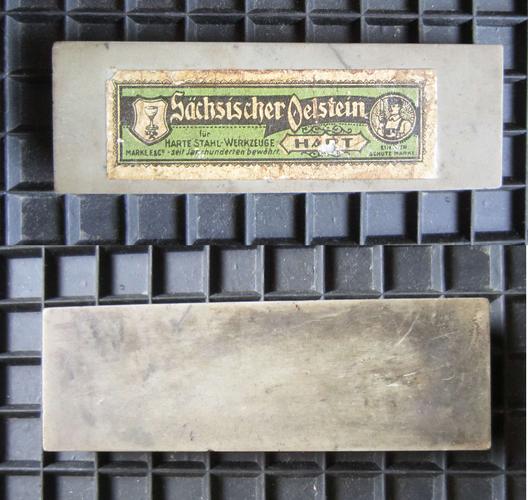
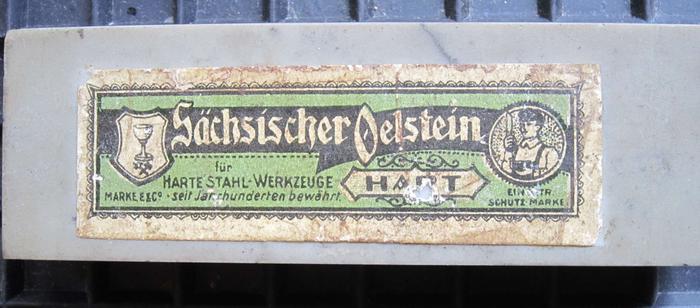
The stone is specified as hard quality and for use with hard steel tools. So there might be also stones labeled “medium” (most probably not “soft” because the stones of this mine are all very hard).
The troutstones are very fine stones and could well be used as finisher for straight razors.
Sham and Mike did some tests on the stones for me in order to classify this stones in a range with other hard novaculite stones in regard of usage as straight razor finisher. Many thanks to both also here at SRP !
You will find the tests here:
Testing hones from Germany
Novaculite or Chert natural hone test


-
The Following 33 Users Say Thank You to hatzicho For This Useful Post:
25609289 (01-31-2014), Adam G. (01-28-2014), AlanII (01-27-2014), Bushdoctor (01-28-2014), claudius (09-08-2023), Danricgro (01-26-2014), dimab (12-09-2019), doorsch (01-28-2014), Double0757 (01-26-2014), Eddys (02-02-2014), gadavier (01-26-2014), GeauxLSU (01-26-2014), Geezer (01-28-2014), JSmith1983 (01-27-2014), Kees (01-29-2014), Margeja (01-27-2014), mjsorkin (01-26-2014), MuskieMan33 (01-29-2014), Nikolay (01-26-2014), PierreR (01-27-2014), Piet (01-26-2014), randydance062449 (12-07-2019), RezDog (01-26-2014), robellison01 (01-28-2014), Rockabillyhelge (01-29-2014), rolodave (02-23-2017), ScoutHikerDad (01-29-2014), Tack (01-26-2014), Thaeris (02-26-2017), tinkersd (02-23-2017), Vasilis (01-26-2014), WadePatton (02-03-2014), WW243 (01-29-2014)
-
01-27-2014, 11:03 PM #2

Thanks for the write up. Quite interesting for sure.
My friends call me Bear.
-
01-27-2014, 11:42 PM #3

Very interesting. Thanks for sharing.
-
01-27-2014, 11:58 PM #4

Are the ordovician stones better than the devonian Stones?
Just kidding, great write-up.No matter how many men you kill you can't kill your successor-Emperor Nero
-
01-28-2014, 04:19 PM #5

Thanks Peter.....and great that you in Person scored that one
....a piece of history and also the only one of this kind i have seen up to date....
-
01-29-2014, 09:29 AM #6

Hi everyone,
The stones remind me of the following:
During a visit to MST Müller in Bad Münster am Stein I saw a Catalog
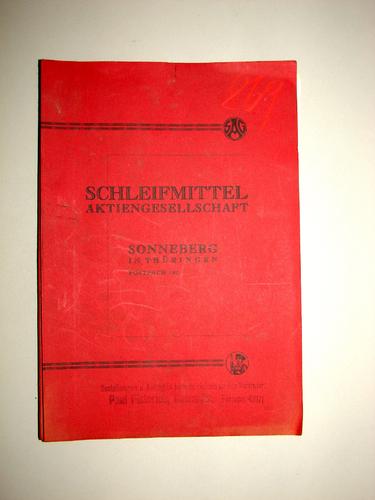
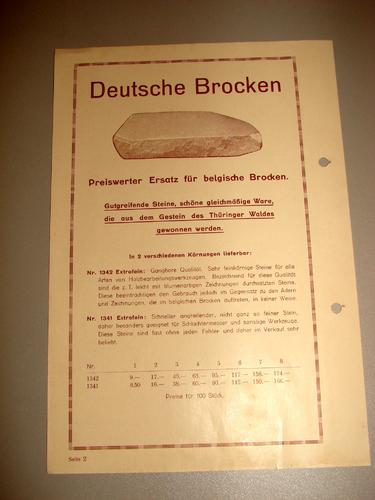
A similar type of stone I encountered in the Slate Museum in Ludwigstadt
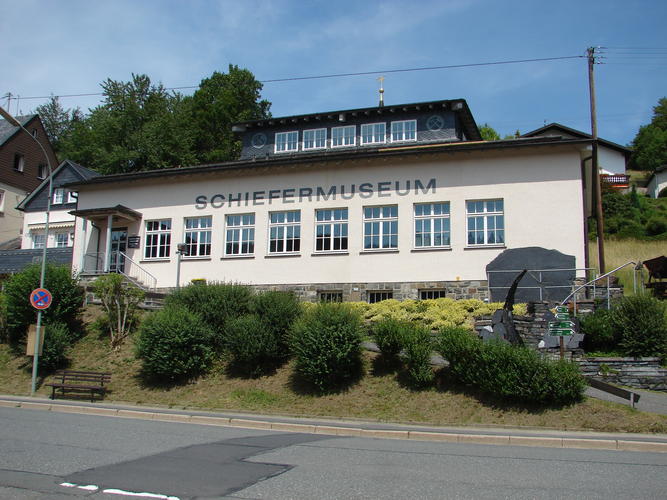

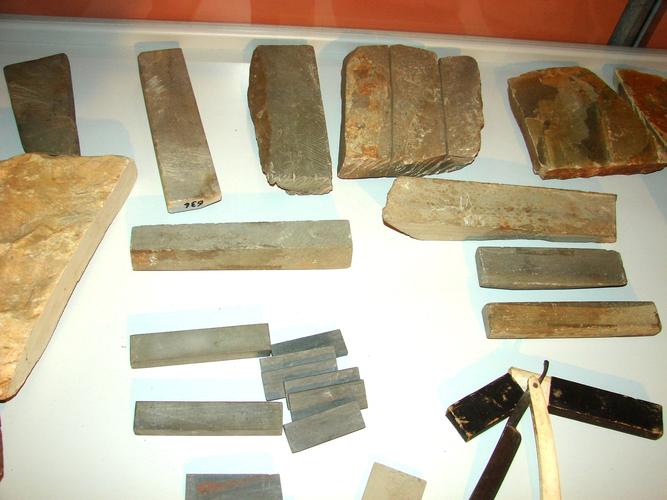
-
The Following 3 Users Say Thank You to Margeja For This Useful Post:
MuskieMan33 (01-29-2014), stilus (01-28-2017), tinkersd (02-23-2017)
-
01-29-2014, 09:15 PM #7

Anybody else notice how the chalice with the cup and cross underneath it look very similar to the Escher chalice? I guess it makes sense if Escher sold this stone under a different name. Just stood out to me. The other stone even says, "Marke E&Co." Sorry to point out the obvious but I've never seen or heard about these stones. That is an interesting read for sure! I'm going to bookmark this page.
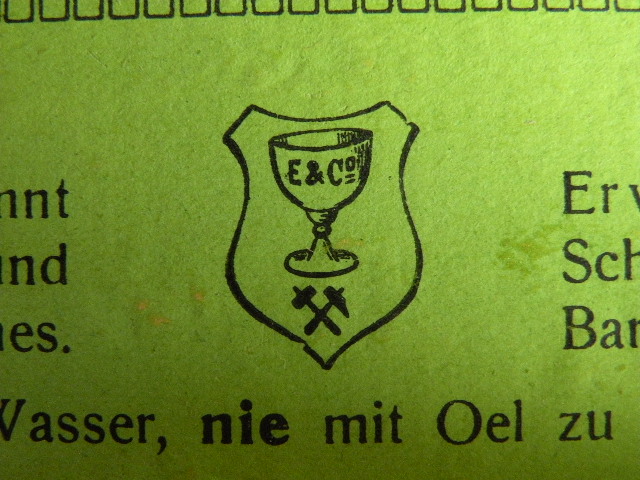

Last edited by MuskieMan33; 01-29-2014 at 09:20 PM.
Sippin' on some slurry.
-
01-29-2014, 09:19 PM #8
 Ordovician Thuringian Hones II – The Escher Quarry
Ordovician Thuringian Hones II – The Escher Quarry
@muskieman:
You should read the whole thing ;-) as Peter wrote it seems to be a stone mined in one of the older Escher quarries and yes the Cup and i also think the Boy with the knife/razor is a trademark...
@hatzicho:
i do not know this, isnt the boy with the knife/razor also a known Escher trademark or a picture they used sometimes ?███▓▒░░.RAZORLOVESTONES.░░▒▓███
-
01-30-2014, 05:42 PM #9

@ henk
Interesting cataloque! The Schleifmittel AG was founded 1923 out of the Escher & Co, Bösenberg & Trinks, Pike & Escher and some other companies. They and the JGES company which was founded out of the Escher & Son company also sold thuringian bouts (Brocken) in analogy to the coticule bouts. Means stones of different shapes, which could not be cut as bench stones. Bouts were sold from ordovician and also the devonion stones. I got a lot of two colored (Yellow-green/Blue "Barbers deligth") waterwhetstone bouts which have triangle and other shape. So it is not clear to me which stones are meant here. Do you have a better copy of this cataloque side?
Since the mine that we talk about was closed 1923, the cataloque may not deal with the aforementioned stones.
The stones showed in the slate museum of Ludwigstadt are all from the different ordovician quarries in the Bavarian/Frankonian area. I have visited the quarries about two years ago. This will be handled in a separate thread (ordovician part 3) - if of interest for the members here.
@MuskieMann33
Yes this is definately an Escher labeled stone. Not only the cup, below the cup you can also read: "Marke E&Co" = brand Escher&Co. The man with knife in the hand on the other side of the logo was the trade mark of Bösenberg&Trinks.
So that is interesting. Bösenberg&Trinks Company (BTC) rented the quarry from about 1870 on. Escher&Co stilll existed at this time. The companies were owned by different kins of the Escher family.
I think the stone was mined after 1870 by BTC. But the stones had become famous under the trademark Escher&Co. So BTC stated on the label brand E&Co and the well know Escher cup beside their own trademark (most probably with acceptance of Escher&Co).
@ doorsch
I think the above explain the item. The Schleifmittel AG used this logo (which they took over from BTC) until after WW2.
-
01-30-2014, 05:44 PM #10

@hatzicho
I think that we are all intetested in a third part.....
Thanks for your explanation....███▓▒░░.RAZORLOVESTONES.░░▒▓███


 62Likes
62Likes LinkBack URL
LinkBack URL About LinkBacks
About LinkBacks






 Reply With Quote
Reply With Quote
